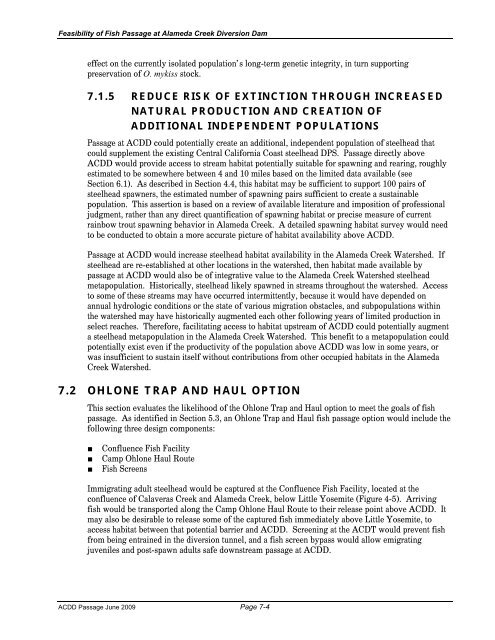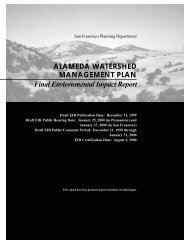Feasibility of Fish Passage at Alameda Creek Diversion Dam
Feasibility of Fish Passage at Alameda Creek Diversion Dam
Feasibility of Fish Passage at Alameda Creek Diversion Dam
Create successful ePaper yourself
Turn your PDF publications into a flip-book with our unique Google optimized e-Paper software.
<strong>Feasibility</strong> <strong>of</strong> <strong>Fish</strong> <strong>Passage</strong> <strong>at</strong> <strong>Alameda</strong> <strong>Creek</strong> <strong>Diversion</strong> <strong>Dam</strong>effect on the currently isol<strong>at</strong>ed popul<strong>at</strong>ion’s long-term genetic integrity, in turn supportingpreserv<strong>at</strong>ion <strong>of</strong> O. mykiss stock.7.1.5 REDUCE RISK OF EXTINCTION THROUGH INCREASEDNATURAL PRODUCTION AND CREATION OFADDITIONAL INDEPENDENT POPULATIONS<strong>Passage</strong> <strong>at</strong> ACDD could potentially cre<strong>at</strong>e an additional, independent popul<strong>at</strong>ion <strong>of</strong> steelhead th<strong>at</strong>could supplement the existing Central California Coast steelhead DPS. <strong>Passage</strong> directly aboveACDD would provide access to stream habit<strong>at</strong> potentially suitable for spawning and rearing, roughlyestim<strong>at</strong>ed to be somewhere between 4 and 10 miles based on the limited d<strong>at</strong>a available (seeSection 6.1). As described in Section 4.4, this habit<strong>at</strong> may be sufficient to support 100 pairs <strong>of</strong>steelhead spawners, the estim<strong>at</strong>ed number <strong>of</strong> spawning pairs sufficient to cre<strong>at</strong>e a sustainablepopul<strong>at</strong>ion. This assertion is based on a review <strong>of</strong> available liter<strong>at</strong>ure and imposition <strong>of</strong> pr<strong>of</strong>essionaljudgment, r<strong>at</strong>her than any direct quantific<strong>at</strong>ion <strong>of</strong> spawning habit<strong>at</strong> or precise measure <strong>of</strong> currentrainbow trout spawning behavior in <strong>Alameda</strong> <strong>Creek</strong>. A detailed spawning habit<strong>at</strong> survey would needto be conducted to obtain a more accur<strong>at</strong>e picture <strong>of</strong> habit<strong>at</strong> availability above ACDD.<strong>Passage</strong> <strong>at</strong> ACDD would increase steelhead habit<strong>at</strong> availability in the <strong>Alameda</strong> <strong>Creek</strong> W<strong>at</strong>ershed. Ifsteelhead are re-established <strong>at</strong> other loc<strong>at</strong>ions in the w<strong>at</strong>ershed, then habit<strong>at</strong> made available bypassage <strong>at</strong> ACDD would also be <strong>of</strong> integr<strong>at</strong>ive value to the <strong>Alameda</strong> <strong>Creek</strong> W<strong>at</strong>ershed steelheadmetapopul<strong>at</strong>ion. Historically, steelhead likely spawned in streams throughout the w<strong>at</strong>ershed. Accessto some <strong>of</strong> these streams may have occurred intermittently, because it would have depended onannual hydrologic conditions or the st<strong>at</strong>e <strong>of</strong> various migr<strong>at</strong>ion obstacles, and subpopul<strong>at</strong>ions withinthe w<strong>at</strong>ershed may have historically augmented each other following years <strong>of</strong> limited production inselect reaches. Therefore, facilit<strong>at</strong>ing access to habit<strong>at</strong> upstream <strong>of</strong> ACDD could potentially augmenta steelhead metapopul<strong>at</strong>ion in the <strong>Alameda</strong> <strong>Creek</strong> W<strong>at</strong>ershed. This benefit to a metapopul<strong>at</strong>ion couldpotentially exist even if the productivity <strong>of</strong> the popul<strong>at</strong>ion above ACDD was low in some years, orwas insufficient to sustain itself without contributions from other occupied habit<strong>at</strong>s in the <strong>Alameda</strong><strong>Creek</strong> W<strong>at</strong>ershed.7.2 OHLONE TRAP AND HAUL OPTIONThis section evalu<strong>at</strong>es the likelihood <strong>of</strong> the Ohlone Trap and Haul option to meet the goals <strong>of</strong> fishpassage. As identified in Section 5.3, an Ohlone Trap and Haul fish passage option would include thefollowing three design components:■■■Confluence <strong>Fish</strong> FacilityCamp Ohlone Haul Route<strong>Fish</strong> ScreensImmigr<strong>at</strong>ing adult steelhead would be captured <strong>at</strong> the Confluence <strong>Fish</strong> Facility, loc<strong>at</strong>ed <strong>at</strong> theconfluence <strong>of</strong> Calaveras <strong>Creek</strong> and <strong>Alameda</strong> <strong>Creek</strong>, below Little Yosemite (Figure 4-5). Arrivingfish would be transported along the Camp Ohlone Haul Route to their release point above ACDD. Itmay also be desirable to release some <strong>of</strong> the captured fish immedi<strong>at</strong>ely above Little Yosemite, toaccess habit<strong>at</strong> between th<strong>at</strong> potential barrier and ACDD. Screening <strong>at</strong> the ACDT would prevent fishfrom being entrained in the diversion tunnel, and a fish screen bypass would allow emigr<strong>at</strong>ingjuveniles and post-spawn adults safe downstream passage <strong>at</strong> ACDD.ACDD <strong>Passage</strong> June 2009 Page 7-4








